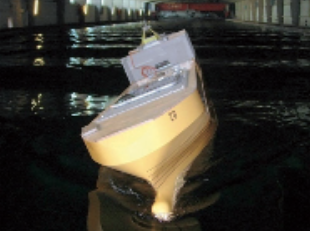Pruebas de estabilidad en buques de guerra averiados con base en ANEP-77: Estudio de caso para F-110
DOI:
https://doi.org/10.25043/19098642.146Palabras clave:
Código de Buques Navales, ANEP-77, estabilidad de averías, evaluación de seguridad de las naves, escenarios de daños, fenómenos dinámicos, colisión, naufragio, criterio de seguridad de averías, pruebas modeloResumen
Las pruebas de estabilidad son una parte fundamental de un diseño de busques de guerra hidrodinámicos. El conocimiento adquirido de la cuenca del modelo hidrodinámico afectará su vida útil. En particular, una valoración de la seguridad de las naves averiadas que considera las condiciones ambientales como el oleaje y el viento, es crítico para operaciones futuras. Durante la última década, una experiencia significativa ha sido adquirida respecto de la predicción del comportamiento de la zozobra de buques militares averiados e intactos y el principal objetivo de este ensayo es dar perspectivas sobre los diferentes aspectos físicos relevantes para prevenir la zozobra de naves averiadas en olas mediante el seguimiento del Código de Buques Navales (NSC) o normas ANEP-77. Actualmente, la Armada Real de España esta desarrollando la futura clase de fragata F-110 y realizó pruebas modelo en el Canal de Experiencias Hidrodinámicas de El Pardo (CEHIPAR) para optimizar las formas de cascos de cuerpo. Entre estas experiencias dinámicas, las más críticas son las pruebas de estabilidad de averías. Aunque el criterio de seguridad de las naves averiadas que considera las condiciones ambientales tales como oleaje y viento no ha sido aún desarrollado, la OTAN y la sociedades de clasificación marítimas europeas han desarrollado guías para la evaluación de seguridad tales como la ANEP-77. Este código contiene escenarios de averías y condiciones ambientales.
Descargas
Citas
NATO Standardization Agency (NSA), Naval Ship Code. Allied Naval Engineering Publication, August 2014, ANEP-77, Ed. F, ver.1. Brussels:
Marina Militare Italiana, Available: https://marina.difesa.it
Pérez, R. and Riola, J.M., “Case study of damage stability criteria of Merchant vessels and Warships”, Damaged Ship International Conference. 26-27 January 2011. London, UK.
Pérez, R. and Riola J.M., “Damage Stability Criteria in Aircraft Carriers,”in Journal of Marine Technology and Environment, Vol. 1, 2011, pp. 27-38.
Riola, J.M., “Estudio dinámico de la supervivencia en la mar de buques ferries con avería. Altura de agua sobre la cubiertadel garaje e influencia de la superestructura,” Phd thesis UPM, 2001, Madrid.
Riola, J.M. and Perez, R., “Warship damage stability criteria case study,” in Journal of Maritime Research, 6(3), 2009, pp.75-100.
Riola. J.M. and Valle, J., “Transient flooding in a damaged ferry,” PRADS 2001, 2001, Shanghai, China.
US Navy, Naval Ship Engineering Center, Design Data Sheet-Stability and Buoyancy of US Naval Surface Ships. DDS 079-1. US Navy, currently Naval Sea Systems Command, 1975, Washington, USA.
Riola, J.M., De la Puente, J., Gómez, F., “Cambios en la normativa de Estabilidad Militar,” 55o Congreso de Ingeniería Naval e Industria Marítima, 2016.
Riola J.M., Pérez-Villalonga, F.J., “Naval Ship Code, Una nueva normativa internacional para buques de Guerra,” in Revista General de Marina, June 2008.
Sarchin, T.H. and Goldberg, L.L., “Stability and buoyancy criteria for the U.S. naval surface ships. Trans,” SNAME. Vol. 70, 1962, 418-458.
Surko, S.W., “An assessment of current warship damaged stability criteria,” in Naval Engineers Journal, Vol. 106, No 2, 1994, pp. 120-131.
Weiss, F., USS STARK, Photogrphic History of US Navy: NavSource. Available: www.navsource.org

Descargas
Publicado
Cómo citar
Evento
Sección
Licencia
The authors who publish in this Journal certify that:
- The work submitted for publication in The Ship Science and Technology journal, was written by the author, given that its content is the product of his/her direct intellectual contribution.
- All data and references to material already published are duly identified with their respective credits and are included in the bibliographic notes and quotations highlighted as such.
- All materials submitted for publication are completely free of copyrights; consequently, the author accepts responsibility for any lawsuit or claim related with Intellectual Property Rights thereof, Exonerating of responsibility to The Science and Technology for the Development of Naval, Maritime, and Riverine Industry Corporation, COTECMAR.
- In the event that the article is chosen for publication by The Ship Science and Technology journal, the author state that he/she totally transfers reproduction rights of such to The Science and Technology for the Development of Naval, Maritime, and Riverine Industry Corporation, COTECMAR.
- The authors retain the copyright and transfer to COTECMAR the right of publication and reproduction of the work which will be simultaneously subject to the Creative Commons Attribution License (CC - BY), which allows the license to copy, distribute, display and represent the work and to make derivative works as long as it recognizes and cites the work in the manner specified by the author or licensor.
- For more information about the Creative Commons Attribution License (CC -BY) and his use and scope, please visit the following web page https://creativecommons.org/licenses/by-sa/4.0/legalcode








